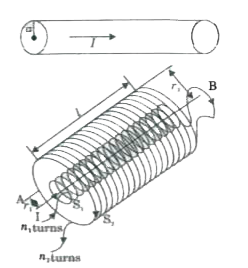A solid cylinder carries current of 1 A uniformly distributed over its cross sectional area. Calculate the magnetic field induction at point P, at a distance of 3 cm from the axis of cylinder, if its radius is 7 cm .
The correct Answer is:1.22×10−6T
To solve the problem of finding the magnetic field induction at point P, which is at a distance of 3 cm from the axis of a solid cylinder carrying a current of 1 A uniformly distributed over its cross-sectional area, we can follow these steps:
Step 1: Identify the parameters
- Current (I) = 1 A
- Distance from the axis to point P (r) = 3 cm = 0.03 m
- Radius of the cylinder (R) = 7 cm = 0.07 m
Step 2: Use Ampere's Circuital Law
According to Ampere's Circuital Law, the magnetic field (B) around a closed loop is given by:
B⋅DL=μ0⋅Ienclosed
Where:
- μ0 = permeability of free space = 4π×10−7T m/A
Step 3: Determine the enclosed current
Since the current is uniformly distributed over the cross-section of the cylinder, we need to find the current enclosed by a circular loop of radius 3 cm. The current density (J) can be calculated as:
J=IA=IπR2
Where A is the area of the cross-section of the cylinder.
The area of the entire cross-section of the cylinder is:
A=πR2=π(0.07)2
Now, calculate the current density:
J=1π(0.07)2
The area of the circular loop of radius 3 cm is:
Aloop=π(0.03)2
The enclosed current Ienclosed in the loop is given by:
Ienclosed=J⋅Aloop
Substituting the values:
Ienclosed=(1π(0.07)2)⋅π(0.03)2
Step 4: Simplify the expression for enclosed current
The π cancels out:
Ienclosed=(0.03)2(0.07)2⋅1
Calculating this gives:
Ienclosed=0.00090.0049≈0.1837A
Step 5: Apply Ampere's Law
Now we can substitute Ienclosed back into Ampere's Law:
B⋅(2πr)=μ0⋅Ienclosed
Where r=0.03m:
B⋅(2π(0.03))=(4π×10−7)⋅(0.1837)
Step 6: Solve for B
Now, simplify:
B⋅(0.06π)=(4π×10−7)⋅(0.1837)
Dividing both sides by 0.06π:
B=(4×10−7⋅0.1837)0.06
Calculating this gives:
B≈1.224×10−5T
Final Answer
The magnetic field induction at point P is approximately:
B≈1.224×10−5T
---
- Current (I) = 1 A
- Distance from the axis to point P (r) = 3 cm = 0.03 m
- Radius of the cylinder (R) = 7 cm = 0.07 m
According to Ampere's Circuital Law, the magnetic field (B) around a closed loop is given by:
B⋅DL=μ0⋅Ienclosed
Where:
- μ0 = permeability of free space = 4π×10−7T m/A
Since the current is uniformly distributed over the cross-section of the cylinder, we need to find the current enclosed by a circular loop of radius 3 cm. The current density (J) can be calculated as:
J=IA=IπR2
Where A is the area of the cross-section of the cylinder.
A=πR2=π(0.07)2
J=1π(0.07)2
Aloop=π(0.03)2
Ienclosed=J⋅Aloop
Ienclosed=(1π(0.07)2)⋅π(0.03)2
The π cancels out:
Ienclosed=(0.03)2(0.07)2⋅1
Ienclosed=0.00090.0049≈0.1837A
Now we can substitute Ienclosed back into Ampere's Law:
B⋅(2πr)=μ0⋅Ienclosed
B⋅(2π(0.03))=(4π×10−7)⋅(0.1837)
Now, simplify:
B⋅(0.06π)=(4π×10−7)⋅(0.1837)
B=(4×10−7⋅0.1837)0.06
B≈1.224×10−5T
The magnetic field induction at point P is approximately:
B≈1.224×10−5T
Topper's Solved these Questions
- BOOK - MODERN PUBLICATIONCHAPTER - MOVING CHARGES AND MAGNETISMEXERCISE - Conceptual Questions29videos
MOVING CHARGES AND MAGNETISM
- BOOK - MODERN PUBLICATIONCHAPTER - MOVING CHARGES AND MAGNETISMEXERCISE - Tough & Tricky (PROBLEMS )15videos
MOVING CHARGES AND MAGNETISM
- BOOK - MODERN PUBLICATIONCHAPTER - MOVING CHARGES AND MAGNETISMEXERCISE - CHAPTER PRACTICE TEST13videos
MOVING CHARGES AND MAGNETISM
- BOOK - MODERN PUBLICATIONCHAPTER - MAGNETISM AND MATTEREXERCISE - CHAPTER PRACTICE TEST FOR BOARD EXAMINATION16videos
MAGNETISM AND MATTER
- BOOK - MODERN PUBLICATIONCHAPTER - NUCLEIEXERCISE - CHAPTER PRACTICE TEST FOR BOARD EXAMINATION15videos
NUCLEI
Similar Questions
A long straight solid conductor of radius 5(~cm) carries a current of 2 A waich is uniformly distributed over its circular cross-section. If the magnetic field induction at a distunce of 3 cm from the axis of the conductor is y×10−6T, then find the value of y.
View SolutionA long straight solid metal rod of radius 4cm carries a current 2A, uniformly distributed over its circular cross-section. Find the magnetic field induction at a distance 3cm from the axis of the wire.
View Solution
Knowledge Check
- Question 1 - Select One
A cylindrical long wire of radius R carries a current I uniformly distributed over the cross sectional area of the wire. The magnetic field at a distance x from the surface inside the wire is
Aμ0I2π(R−x)Bμ0I2πxCμ0I2π(R+x)Dnone of these - Question 2 - Select One
A long straight wire of radius 10mm carries a current uniformly distributed over its cross section. The ration of magnetic fields due to the wire at distance of 5mm and 15 mm, respectively from the axis of the wire is
A34B23C13D2 - Question 3 - Select One
A long staright wire of radius a carries a steady current I. The curent is unifromly distributed over its cross-section. The ratio of the magnetic fields B and B' , at radial distances a2 and 2a respectively from the axis of the wire is:
A14B12C1D4
A long straight solid conductor of radius 6cm carries a current of 8A, which uniformly distributed over its circular cross-section. Find the magnetic field (a) at a distance of 3cm from the axis of the conductor (b) at a distance 10cm from the axis of the conductor.
View SolutionA long straight solid conductor of radius 5cm carries a current of 3A, which is uniformly distributed over its circular cross-section. Find the magnetic field induction at a distance 4cm from the axis of the conductor. Relative permeability of the conductor=1000.
View SolutionA long thick conducting cylinder of radius 'R' carries a current uniformly distributed over its cross section :
View SolutionThe adjoining figure shows a long straight wire of a circular cross section (radius a) carrying steady current I. The current I is uniformly distributed across its cross section. Calculate the magnetic field at a distance from its axis for (i)r<a,(ii)r>a.
 View Solution
View SolutionA long, cylindrical wire of radius b carries a current i distributed uniformly over its cross section. Find the magnitude of the magnetic field at a point inside the wire at a distance a from the axis.
View Solution

